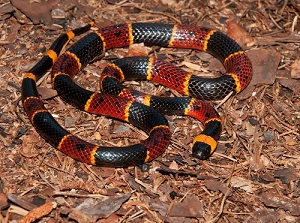Outdoor job sites often bring workers into environments where venomous snakes may be present, and even routine tasks can turn hazardous without proper awareness.
Snakes usually avoid confrontation, but accidents happen when they are startled, stepped on, or reached toward without being seen. Workers who perform tasks in natural, wooded, sandy, wet, or overgrown areas must understand how to recognize snake hazards and how to respond safely.
Snakes may hide in tall grass, dense brush, wood piles, foundation gaps, ditches, logs, and under equipment left outdoors. Some species burrow underground or camouflage easily against soil or leaves, making them difficult to detect until a worker is very close.
These job types may come across snakes more frequently:
- Forestry and logging operations
- Landscaping and brush clearing
- Utility and pipeline work
- Groundskeeping and general property maintenance
- Construction and excavation
- Road, bridge, and drainage projects
- Disaster cleanup and storm recovery
OSHA Standard 1926.21(b)(4) requires employers to train workers about hazards posed by harmful animals and provide instruction on avoidance techniques and correct first aid procedures.
One venomous species workers should be familiar with is the coral snake.

Coral Snake Identification and Habitat
Coral snakes are easily recognized by their distinct red, yellow, and black banding pattern. The key identifying feature:
Red bands touch yellow bands.
This is where the common saying comes from:
“Red touches yellow, kill a fellow. Red touches black, friend of Jack.”
This rhyme helps workers distinguish venomous coral snakes from harmless look-alike species such as scarlet kingsnakes or milk snakes.
Adult coral snakes are small and slender compared to other venomous snakes, but their venom is extremely potent. Coral snakes may be found in:
- Wooded or forested areas
- Sandy or scrub habitats
- Marshes, wetlands, and coastal regions
- Burrows beneath leaf piles or loose soil
- Under logs, boards, or debris
Coral snakes live primarily in the Southern United States, including states across the Southeast and parts of the Southwest.
These snakes are shy and reclusive. Coral snakes will almost always attempt to escape when threatened and typically bite only when handled or accidentally pressed against.
What Makes Coral Snakes Dangerous
While coral snake bites are rare, their venom is neurotoxic, meaning it affects the nervous system. Unlike pit viper bites, coral snake bites may not cause immediate pain or swelling. This can be deceptive because most symptoms do not appear until several hours later, sometimes up to 12 hours after the bite.
If left untreated, a coral snake bite can be fatal, making early medical intervention absolutely critical.
Safety Precautions for Avoiding Snake Bites
During safety meetings about snake hazards, emphasize these important precautions:
- Stay alert when working in leaf piles, brush, wood stacks, or sandy soil where coral snakes may hide.
- Wear heavy-duty gloves when moving debris or reaching into concealed areas.
- Use sturdy boots to help protect against bites to the feet and ankles.
- Never place your hands or feet where you cannot see.
- Do not attempt to chase, catch, or kill any snake. Coral snakes are much more likely to bite if handled.
- If you spot a snake, slowly move back and give it room to leave.
- Keep job sites picked up and reduce clutter where snakes can hide.
What To Do If Someone Is Bitten by a Snake
If a worker is bitten by a coral snake (or any other snake):
- Call 911 immediately. Do not wait for symptoms. Coral snake venom acts slowly but is extremely dangerous.
- Note the snake’s color pattern if possible, or have someone safely take a photo from a distance.
- Keep the victim calm and still to slow venom spread.
- Lay the person down with the bite below heart level.
- Apply a clean, dry bandage over the bite.
- Do not cut the wound, apply ice, use a tourniquet, or attempt to suck out the venom.
- Stay with the victim until emergency personnel arrive.
Quick medical care significantly improves outcomes for coral snake bites.
Staying Safe in Snake-Prone Work Areas
Through proper training, awareness, and consistent use of safe work practices, employees can greatly reduce their chances of encountering coral snakes or suffering a bite. Regular safety meetings and clear communication help ensure that every worker understands the hazards and knows how to respond appropriately.
With the right precautions, workers can remain safe while performing tasks in environments where venomous snakes may be present.
.jpeg)

.jpg)